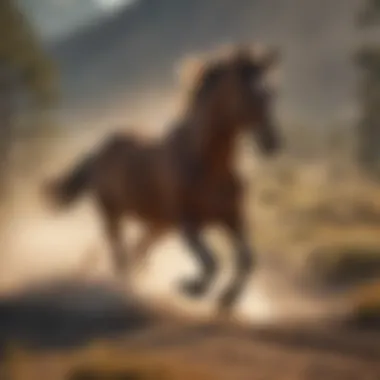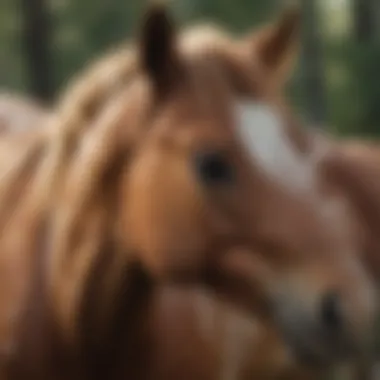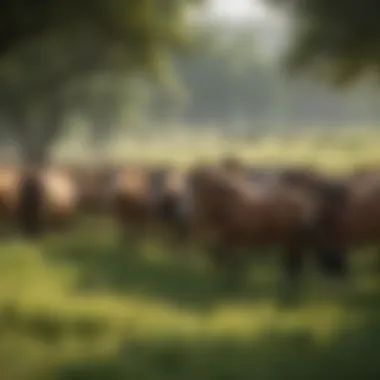Wild Mustangs in America: Origins and Conservation


Intro
The wild mustangs of America represent not just a species of horse, but a profound symbol of the rich history intertwined with the American landscape. These animals, often romanticized in folklore and media, are deeply rooted in the ecological and cultural fabric of the country. Understanding wild mustangs goes beyond their majestic appearance. It requires an exploration into their origins, biology, and the multifaceted challenges they face today. This article aims to provide a thorough overview of wild mustangs, looking at their environmental significance, historical context, and ongoing conservation efforts.
Overview of Wild Mustangs
Wild mustangs trace their lineage back to the early days of European colonization in North America. They are believed to be descendants of domesticated horses brought by Spanish explorers in the 16th century. Over time, these horses escaped or were released into the wild, adapting and forming feral populations.
The biology of wild mustangs includes various breeds, exhibiting a range of colors and sizes. These animals are well-adapted to the environments in which they roam, often found in open plains, deserts, and mountainous terrains. Their social structure is typically based on herds, which is critical for their survival and lineage.
The ecological significance of wild mustangs cannot be overstated. They contribute to the biodiversity of the regions they inhabit, influencing plant dynamics and promoting ecosystem balance. However, with their presence come challenges concerning land management and conservation strategies.
"Wild mustangs are not just a part of America's history; they play a crucial role in its ecological future."
Conservation Challenges
The management of wild mustangs has ignited contentious debates. In recent decades, increasing populations have led to conflicts with land use, particularly in grazing lands managed for livestock. This has prompted the Bureau of Land Management (BLM) to implement various strategies, including roundups and adoptions, aimed at controlling mustang populations.
Current conservation initiatives are diverse and often contentious. Some organizations advocate for the protection of mustangs in their natural habitats, while others push for more direct management approaches. Proponents of the wild horse preservation argue that these animals face threats from habitat loss, climate change, and overpopulation, while also emphasizing the need for sustainable practices in rangeland use.
Sustainable Practices in Wild Mustang Management
To effectively balance the needs of wild mustangs with land management, principles of sustainability are essential. Key strategies include:
- Monitoring populations: Keeping track of mustang herds aids in making informed management decisions.
- Habitat restoration: Efforts to restore degraded land improve conditions for mustangs and other wildlife.
- Community involvement: Engaging local communities fosters support for conservation initiatives and sustainable land use.
Adopting these practices can help minimize conflicts while ensuring the viability of wild mustang populations. Incorporating community input helps address socio-political challenges and promotes a collective effort towards conservation.
Epilogue
Wild mustangs are a vital component of America's ecological and cultural heritage. Understanding their origins, roles, and the challenges they face enriches the discourse around their conservation. As stakeholders navigate the complexities of land management, informed discussion will be key to ensuring both the survival of these iconic animals and the health of their ecosystems.
Prelims to Wild Mustangs
The wild mustangs represent a compelling aspect of American natural heritage. Their presence on the plains and rugged terrains of the West is not merely a symbol of freedom; it highlights deep ecological interconnections and historical narratives. Understanding wild mustangs is essential to grasping the complexities of land conservation and wildlife management practices in the United States. Moreover, they serve as a focal point for discussions about biodiversity, environmental stewardship, and socio-political dynamics affecting both the animals and the ecosystems they inhabit.
Defining Wild Mustangs
Wild mustangs are free-roaming horses found primarily in the western United States. These animals are often descended from various breeds introduced by Spanish explorers in the 16th century. Over time, they adapted to the diverse American landscapes, becoming an integral part of the ecosystem.
Mustangs are characterized by their physical stamina, adaptability to harsh environments, and their distinct social structures. The term 'mustang' itself usually refers to unbranded feral horses. Their blended heritage results in a range of colors and sizes. It is this variety that often captivates observers and underscores their wild nature.
Historical Context of Mustangs in America
The historical journey of mustangs in America is complex and intertwined with human activities. Initially, these horses thrived in an environment where they had few natural predators. The arrival of European settlers, however, shifted this dynamic significantly.


In the 19th century, mustangs became symbols of the American frontier, embodying the spirit of exploration and rugged individualism. However, as settlers expanded their territories, the mustangs faced habitat loss and competition for resources.
Today, mustangs are a subject of heated debate. The government must balance conservation with ranching interests, leading to tensions over land use and management.
"The story of the wild mustang is not just their survival but also a reflection of human values and our relationship with nature."
Understanding the historical context of wild mustangs is crucial in forming effective policies for their management and conservation.
Biological and Ecological Aspects
The biological and ecological aspects of wild mustangs are crucial to understanding their role in the American landscape. This section explores the unique traits of mustangs and their adaptation to the environment they inhabit. Knowing these traits informs discussions about conservation and management practices that affect both the horses and their ecosystems.
Physical Characteristics and Adaptations
Wild mustangs, known for their resilience, exhibit a variety of physical characteristics. They typically have a compact build, which aids their survival in the rugged terrains of the American West. Their coat colors range widely from bay, chestnut, pallomino, to roan, facilitating better adaptation to diverse climatic conditions. Mustangs have strong legs, promoting agility and endurance, which is essential for escape from predators and for effective foraging.
Their size averages about 14 to 15 hands high at the withers, which is a good balance between strength and speed. Additionally, they possess hard, durable hooves that are well-suited to rocky terrains and extended periods of travel.
Adaptations in their digestive system allow for the efficient processing of low-quality forage, which is plentiful in their natural habitats. This ability to thrive on sparse food sources is essential due to the shifting availability of grasslands across seasons, further underscoring their survival expertise.
Behavioral Patterns and Social Structures
Wild mustangs display complex social structures that help maintain their groups. They typically live in herds led by a dominant stallion, which helps in protecting the mares and young foals. Hierarchy within the herd is established through social interactions and behavior patterns.
Mares often form strong bonds with each other, creating a support system crucial for nurturing foals. The stallions protect the herd from threats, and their presence is fundamental to group cohesion. Communication among mustangs includes body language and vocalizations, showcasing their adeptness in social behavior.
Their migratory behavior is noteworthy as it helps them adapt to seasonal changes in food availability. They travel significant distances to find water and grazing areas, demonstrating their intelligence in resource navigation.
Role in Ecosystems
Wild mustangs play a significant role in shaping their ecosystems. As grazers, they influence plant growth and maintain the health of grasslands. Their movement across various terrains helps disperse seeds, promoting biodiversity.
Overgrazing can lead to negative impacts on the ecosystem, yet a balanced population can support diverse plant life, which in turn benefits other wildlife species. The presence of mustangs can encourage new plant species to emerge, leading to enriched habitats. This interdependence underlines the importance of careful management strategies to maintain ecological balance.
"Wild mustangs are not just part of America's landscape; they are integral to its ecological health."
In summary, the biological and ecological aspects of wild mustangs underscore their adaptability and importance to their environment. Understanding these factors helps illuminate the benefits of preserving mustang populations for ecological integrity.
The Historical Journey of Mustangs
Understanding the historical journey of mustangs is crucial for grasping their role in the American landscape. This section highlights key moments in their evolution from domesticated animals to wild creatures roaming free. It also examines the factors that influence their numbers and habitats today. By studying this history, we can appreciate not just the wild mustangs themselves but also the broader implications for land management, conservation, and cultural heritage.
From Prologue to the Wild
When horses were first brought to America during the 15th and 16th centuries, they were introduced by Spanish explorers. These horses were primarily for work and transport. Over time, some of these horses escaped or were released, leading to the establishment of a feral population. Mustangs adapted to various environments across the continent. Their resilience has allowed them to thrive in diverse habitats, from the arid West to the grasslands. This adaptability is a key factor in their survival through changing landscapes.


Cultural Significance to Native Americans
For Native American tribes, mustangs hold significant cultural value. Horses transformed many tribes' ways of life. They became central to hunting, warfare, and trade. Tribes like the Lakota and the Comanche developed distinct equestrian cultures. These relationships with horses are imbued with spiritual meaning, representing strength, freedom, and connection to the land.
The legacy of mustangs within Native American history shows that they are not merely animals but are woven into the fabric of cultural identity. This connection emphasizes the need for respectful management practices that honor the heritage of both the horses and the tribes.
The Impact of European Settlements
With the arrival of European settlers, the dynamics surrounding mustangs shifted. Settlers viewed these animals through the lens of ownership and exploitation. Land was claimed and fenced off, drastically reducing the space available for mustangs to roam. The population began to decline as competition for resources increased.
In many areas, mustangs were rounded up for domestication or killed for food. This decrease raised concerns about the genetic diversity and future of the wild horse population. Furthermore, European agricultural practices transformed landscapes. These changes affected not only mustangs but also the entire ecosystem.
The historical journey of the mustang reflects the broader themes of colonization, cultural transformation, and environmental stewardship. Understanding this journey provides insight into the present challenges and conservation efforts.
In summary, the historical context of mustangs is vital for understanding their current status and the ongoing efforts for their preservation. Their journey highlights the intricate relationship between humans, land, and nature.
Current Management Practices
Government Policies and Regulations
Wild mustangs are protected under several laws and regulations. The most significant legislation is the Wild Free-Roaming Horses and Burros Act of 1971. This act was established to protect the horses and burros living on public lands in the United States. It recognizes their unique value and aims to preserve their populations. However, the effectiveness of this legislation is often challenged by competing interests, including agricultural policies and land management practices.
Moreover, various federal entities manage wild horse populations. The Bureau of Land Management plays a crucial role, monitoring herds and determining appropriate population numbers based on ecological research. Policies can include fertility control measures and roundups to prevent overpopulation. These regulations are the backbone of sustainable management strategies but can also lead to significant debates among conservationists, ranchers, and the public.
Challenges of Overpopulation and Resource Management
One of the main issues related to wild mustang management is overpopulation. Estimates suggest that many mustang herds often exceed the sustainable carrying capacity of their environments. This overpopulation can lead to detrimental impacts on the ecosystems, including degradation of vegetation and competition for resources with native wildlife.
To mitigate these challenges, effective resource management is essential. This includes establishing appropriate population targets, regular monitoring of herd dynamics, and assessing the health of the ecosystems they inhabit. Stakeholders must navigate a complicated landscape of economic, ecological, and social factors when devising these management strategies. Finding solutions that consider all parties remains a pressing challenge.
Adoption and Placement Programs
Adoption and placement programs are critical components of current management practices for wild mustangs. They provide a means to reduce herd sizes while fostering human connections with these animals. Since the early 1970s, the Bureau of Land Management has facilitated numerous adoption events. These initiatives allow individuals and organizations to offer homes to mustangs, which helps in decreasing overpopulated herds.
These programs also emphasize the importance of educating potential adopters about the responsibilities involved in caring for a wild mustang. Successful placements enhance social awareness regarding the nature of these animals and their needs.
"Adoption programs promote not just the well-being of mustangs but also community engagement and stewardship."
In summary, current management practices encompass a multi-faceted approach, involving regulations, addressing challenges, and facilitating adoption. These elements contribute significantly to the conservation and welfare of wild mustangs, while also taking into account the diverse interests surrounding land use in America.
Socio-Political Dynamics
Public Perception and Advocacy
Public perception of wild mustangs often varies widely, shaped by cultural narratives, media representation, and personal beliefs. Many view these animals as symbols of freedom and ruggedness, contributing to their romanticized image. Advocacy groups, such as the Mustang Heritage Foundation and the American Wild Horse Campaign, work tirelessly to promote awareness and drive policy change. They aim to leverage public interest to influence legislation that supports mustang welfare. Advocacy can lead to impactful initiatives, including educational outreach campaigns designed to inform the public about the challenges faced by wild mustangs and the ecosystems they inhabit.


Conflict with Ranchers and Land Use
Wild mustangs often find themselves in conflict with ranchers who rely on grazing land for their livestock. The presence of large herds can lead to the depletion of resources, which results in tension between different land-use priorities. Ranchers may argue that mustangs should be controlled to maintain ecological balance. This leads to heated debates about the best management strategies. Some stakeholders advocate for wild horse populations to be managed closely, while others urge for more humane and sustainable alternatives. The challenge lies in reconciling the needs of ranchers with the rights of wild mustangs, creating an ongoing dialogue about land use that incorporates multiple perspectives.
Legal Framework Governing Wild Mustangs
The legal framework concerning wild mustangs is indeed complex. The Wild Free-Roaming Horses and Burros Act of 1971 established protections for these animals, recognizing their historic presence in the American West. However, this legislation has evolved amid growing concerns about overpopulation and the ecological impact of mustangs on public lands. Different governmental bodies, such as the Bureau of Land Management, implement policies for their management. These policies often stir public debate regarding their effectiveness and ethical implications. The legal landscape, therefore, is shaped by ongoing discussions between policymakers, environmentalists, ranchers, and animal advocates.
"The management of wild mustangs requires a multifaceted approach that considers ecological balance, legal frameworks, and public sentiment."
Conservation Efforts and Future Prospects
Conservation efforts for wild mustangs are crucial for maintaining their populations in a sustainable way while balancing land use and ecological health. These efforts focus on managing the number of mustangs, protecting their habitats, and ensuring that future generations can experience these animals in the wild. Wild mustangs symbolize the spirit of the American West, making their conservation a matter of both ecological and cultural significance.
Innovative Conservation Strategies
Innovative conservation strategies are being developed and implemented to support wild mustang populations. These strategies range from scientific research on herd genetics to habitat restoration projects that improve forage availability. One notable approach is the use of fertility control methods, such as the immunocontraceptive vaccine known as PZP. By managing fertility, populations can be kept at sustainable levels, reducing the need for drastic measures like roundups and removals.
Other strategies include educational campaigns aimed at fostering public support for mustang conservation. These efforts help to raise awareness about the ecological roles of mustangs in their ecosystems. Collaboration with federal and state agencies ensures that management practices align with wildlife conservation goals, promoting healthier ecosystems overall. Protecting migratory routes and critical habitats also plays a vital role in these innovative strategies.
Role of Nonprofit Organizations
Nonprofit organizations are instrumental in the conservation efforts for wild mustangs. They often work directly with government agencies and local communities to advocate for policy changes and to raise funds for projects. Organizations like the American Wild Horse Campaign and The Cloud Foundation play crucial roles in educating the public about the needs of wild mustangs. They also support rescue and rehabilitation efforts for mustangs that are removed from the wild.
These nonprofits often engage volunteers in their initiatives, creating a community centered around the preservation of mustangs. By fostering partnerships with scientists, legal experts, and wildlife advocates, these organizations develop holistic approaches to conservation that consider the welfare of mustangs and the needs of ranchers and other stakeholders.
Community Involvement and Education
Community involvement is another cornerstone of successful conservation efforts. Educating local communities about the importance of mustangs and their ecosystems fosters a sense of responsibility. Grassroots efforts allow community members to play active roles in monitoring mustang populations and their habitats.
Workshops and seminars can provide crucial information on sustainable land management practices that can harmonize the needs of ranchers, wildlife, and wild mustangs. Such initiatives help build a sense of ownership over local ecosystems and promote collaborative problem-solving.
"Educating the community about mustangs is not just about saving a species; it is about enriching our collective identity and ecological heritage."
Overall, the future of wild mustangs relies heavily on innovative conservation strategies, the commitment of nonprofit organizations, and active community involvement. By fostering collaboration and understanding, a sustainable future for mustangs can be achieved, ensuring their presence in the American landscapes for generations to come.
Culmination
The topic of wild mustangs and their conservation is vital in understanding not only the history of these iconic animals but also their current plight in America. This conclusion ties together major insights presented throughout the article, highlighting the multifaceted nature of wild Mustang populations and their interactions with various elements. It underscores the balance needed between preservation and land management due to the socio-political implications surrounding their existence.
Summary of Key Points
Wild mustangs symbolize freedom and resilience in the American landscape. Key points discussed include:
- Defining Characteristics: Wild mustangs are defined not just by their unique physical and behavioral traits but also by their historical significance within American culture.
- Ecological Role: They play a crucial role in their ecosystems, influencing both flora and fauna through grazing patterns and herd dynamics.
- Management Practices: Current complexities concerning government policies, overpopulation, and resource allocation reflect broader tensions that must be addressed.
- Conservation Efforts: Organizations and community programs are working to align human interests with ecological sustainability, emphasizing ongoing education and community involvement.
This synthesis highlights the necessity for an informed approach to wild mustangs, where the aim is not just to protect a species but to understand it within a holistic ecosystem framework.
The Path Forward for Wild Mustangs
Looking ahead, the future of wild Mustangs requires innovative solutions that respect both natural habitats and human necessities. Key considerations would include:
- Adaptive Management Strategies: To manage populations sustainably, adaptive practices that respond to changing environmental conditions and human landscape pressures are essential. This might involve developing rotational grazing systems or collaborative agreements with ranchers.
- Strengthening Legislation: A reevaluation of legal protections may be necessary to ensure wild mustangs have a secure place within the broader wildlife conservation efforts, while being sensitive to agricultural needs.
- Public Education and Advocacy: Increased awareness among the public about the cultural and ecological significance of wild mustangs can lead to greater advocacy and support. As public perceptions shift, this can enhance support for conservation initiatives.















